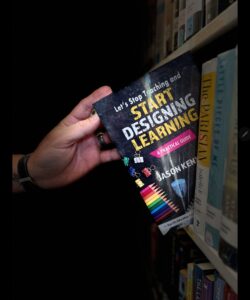Picture a school where learners thrive. Not because one teacher pulls a miracle. Not because a test score spike looks good. But because the system was built for it. Where collaboration isn’t an initiative but a norm. Where expectations are high and clear and consistent. Where the good stuff happens on purpose, not by accident.
Too many schools spend their days chasing the win. The data point. The glowing walk-through. The one moment of magic. And while those wins feel good in the moment, they fade fast. Worse, they burn us out. And then we start chasing all over again. Tired. Disillusioned. Reactive.
What if we stopped chasing? What if we built the kind of school-wide systems that engineer the win and make it stick? That’s what this post is about. It’s for school leaders and teams ready to quit reacting and start designing. We’ll walk through a practical way to build three aligned, focused systems: one instructional, one operational, and one just-for-the-love-of-it. We’ll look at what research says, what it looks like in real schools, and how you can start building today.
Systems Eat Chaos for Breakfast
Here’s the hard truth: isolated wins don’t scale. You can’t clone your superstar teacher. You can’t always predict when a learner will finally “get it.” But you can build the kind of systems where success stops being a happy accident and starts being the norm.
School-wide systems do one essential thing: they reduce variability. That means every learner, no matter who their teacher is, what hallway they’re in, or what mood the building is in that week, has access to rigorous, responsive, purposeful learning. That’s how equity happens. That’s how burnout doesn’t happen.
And the research backs it up. Collective Teacher Efficacy has an effect size of 1.57, one of the strongest levers we have in education. When educators believe they can impact learning outcomes together, they actually do. They stop surviving and start building.
Academic Press, a culture where every learner is expected to do quality, rigorous work, carries an effect size of 0.95. Not the flashiest number, but strong enough to shift a school’s trajectory when embedded in daily routines.
These two forces, efficacy and press, are amplified by systems. When you design the right ones, they feed each other. Efficacy lifts the floor. Press raises the ceiling. Systems lock it in place.
The Rule of Threes (Start Small, Scale Hard)
Overwhelm is real. That’s why the best system builders start with three:
One instructional system (to power the learning)
One operational system (to clean up the noise)
One passion project system (to bring the spark)
Let’s break them down.
1. Instructional System: Data-Driven PLCs That Actually Work
We’ve all been in a PLC that’s really just a meeting. But when done right with structure, data, and a clear goal, PLCs can be a force multiplier. Design a system where Collaborative Teams meet every regularly. Not to “check in,” but to analyze learner work, identify gaps, and plan targeted instruction.
- Use a tight protocol. Teachers bring assessment data, look for patterns, co-plan re-teaching.
- Tie it to outcomes. Set goals: “80% of learners will master X by Y.”
- Build time in the schedule. Protect it. Train your teachers. Data literacy is equity work.
This isn’t just nice to have. It’s one of the highest-yield moves you can make. Collaborative Teams aligned with data-driven practice and academic press create the kind of consistent, high-quality instruction that can’t be derailed by subs, sick days, or system noise.
2. Operational System: Cut the Chaos, Streamline the Signal
Your staff’s inbox is a war zone. Announcements, spreadsheets, meeting invites, celebratory GIFs, and that one parent email from Tuesday still sitting unread. Create a one-stop hub, a single platform where everyone gets what they need, when they need it.
- Weekly digital bulletin. Drop it Monday morning. Clear, concise, useful.
- Shared drive or intranet. No more file scavenger hunts.
- Built-in celebration. Shout out the wins. Build momentum.
This isn’t about logistics. It’s about clarity. And clarity boosts teacher effectiveness. When people know where to look, what to do, and what matters most, they stop spinning. And they start building.
3. Passion Project System: That Thing You Keep Saying You’ll Do
Every school has one. That idea everyone agrees would be amazing. That thing that shows up in planning meetings, PD reflections, or hallway conversations, followed by, “We’ve always wanted to do that…” It might be launching a service-learning program. Or a mentorship network. Or a wellness initiative. It’s something the staff cares about, learners would thrive from, and families would rally around, but for some reason, it never makes it past the wish list. That’s your Passion Project System.
Start with the idea your school keeps circling. Maybe it’s a cross-grade peer mentoring program. Maybe it’s turning that unused courtyard into a learner-led garden and outdoor classroom. Maybe it’s a school-wide initiative focused on physical, mental, or emotional wellness. Whatever it is, it needs a system behind it.
- Survey the stakeholders. Staff. Learners. Families. Find alignment and energy. Make sure it’s not just a good idea—it’s your idea.
- Form a design team. Three to five staff members. One admin. A couple of learners. Maybe even a parent rep.
- Create the infrastructure. Calendar. Milestones. Roles. Resources. Budget (start small, think grants later).
- Connect it to the learning. Don’t let it live on the sidelines. Have learners present projects, reflect on process, and set goals. That’s academic press (effect size 0.43) in action.
When teachers work together to launch something that matters to them, collective efficacy takes root. You stop hearing “We should…” and start seeing “We did.” Leaders, this is where you back the vision with action. Protect the time. Remove the roadblocks. Celebrate the early wins. If it’s a mentoring program, give it airtime in staff meetings. If it’s a wellness push, let learners design the campaign. If it’s service learning, spotlight the impact. And track it all. Not to check a box, but to keep it alive.
This is how you turn “someday” into system. Not an initiative. Not a project on the corner of someone’s desk. A real, structured part of your school’s identity. The kind of thing people talk about when they describe what makes your school your school.
Design the Win
Here’s the call: Stop chasing. Stop surviving. Build it. Start with three systems. Anchor in collective efficacy and academic press. Build what your people need. Not more stuff. Just better systems.
Leaders: pick one place. Audit it. Systematize it. Train. Support. Stick with it.
Educators: lean in. Show up to your Collaborative Teams ready to solve. Log into the platform. Lead the charge. Bring the spark.
Because here’s the truth. We can’t afford one more year of chaos-as-normal or systems-in-name-only. We can’t afford one more win that fizzles. The learners can’t. And neither can we. Build the system. Guarantee the win.


